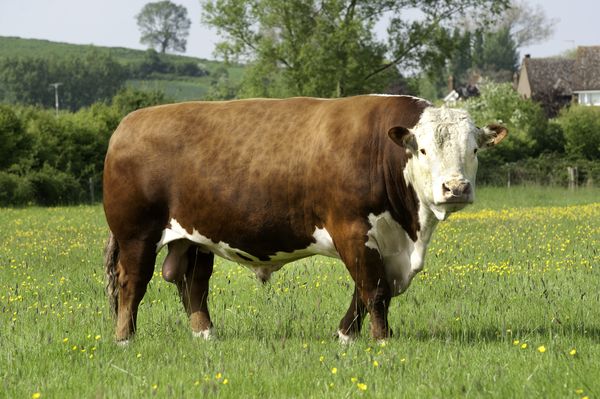Hereford Breed

The breed owns this name from the place of its origin - the English county of Herefordshire on the border with Wales. It began with one of the types of red cattle raised in the 18th century in some southern and western parts of England. Livestock improvement work first focused on increasing body size and muscle strength in order to use animals as a pulling force and a source of meat; no special attention was paid to their milk production at that time. The English studbook of this breed was introduced in 1846. The Herefords have won worldwide recognition, and their characteristic white head is present in all offspring obtained from crossing with other livestock.
The breed adapts well to a hotter climate than in England, and now it is the most numerous and widespread livestock on the planet for beef production. Its influence was experienced by 20-30 other breeds, especially in North America and Russia. In 1950, on the basis of absorptive crossing of bulls - producers of the Hereford breed with local Kazakh cattle, a domestic beef breed was bred and tested - the Qazaq Aqbas, which is famous, first of all, for its rather large size, strength and adaptability to pastures of various types. Hereford cattle were brought to Canada, Mexico, North and South America, Great Britain, Argentina, Uruguay, Brazil, Australia, New Zealand, South Africa and many European countries, southeastern regions of the Russian Federation, Siberia, the Far East and Kazakhstan, where successfully get divorced at the present time.
Animals with a barrel-shaped, squat, wide and deep body, strongly protruding dewlap, well-muscled shoulders. The hair is short in summer, long and curly in winter. Color from cherry to dark red, head, neck, withers, dewlap, belly, lower limbs and tail are white. The nasal mirror is pink. The white-headedness and white color of the belly, characteristic of Hereford cattle, is steadily inherited when crossed with other breeds. Animals of the Hereford breed have a cylindrical body shape typical of beef cattle; the head is small, wide; the dewlap is well developed and protrudes slightly forward, the front and back of the body are well developed; the chest is deep and wide, the back and loin are wide, the rear is wide, straight, with well-developed muscles, the skin is elastic, covered with delicate hair.
At the beginning of the twentieth century. in the United States, herds of hornless livestock were bred, which is becoming more widespread not only in the United States, but also in other countries.
Heifers weigh 30-40 kg at birth, calves 35-45 kg. At the age of 6 months, young animals reach a live weight of 220-250 kg, and by the age of 8 months - 280-300 kg. At the age of 18 months, the live weight of heifers reaches 420 kg., Calves 550 and more kg., Calves 850-1000 kg.
Hereford cattle have good beef qualities and high growth rates. Animals are able to increase live weight for a long time without excessive fat deposition. With intensive rearing, bulls have an average daily gain of 1110-1300 g and by 12 months of age they reach a live weight of 500 kg, with a slaughter yield of 60-65%, sometimes up to 70%. The average daily gain in live weight in bulls reaches up to 2000 grams. Hereford meat has the best taste.
The high energy of growth allows at the age of one and a half years to receive a heavy carcass with a yield of pulp - meat of 5.0-5.5 kg. for 1 kg. bones, the specific gravity of pulp-meat 82-84%.
The animals are early maturing, hardy, adapted to various natural and climatic conditions, long-term keeping on pastures, well tolerate long hauls.
Source: "Technology of production and standardization of beef", Amanzholov K.Zh., Almaty 2013, ISBN 978-601-7856-38-9
